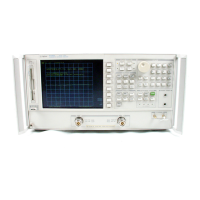11
Error lkrms
The analyzer generates and stores factors in internal arrays when a
measurement error-correction (measurement calibration) is performed. These
factors are known by the following terms:
n
error terms
n
E-terms
n
measurement calibration coefficients
The analyzer creates error terms by measuring
well-deflned
calibration devices
over the frequency range of interest and comparing the measured data with the
ideal model for the devices The differences represent systematic (repeatable)
errors of the analyzer system. The resulting calibration coefficients are good
representations of the systematic error sources. For details on the various levels
of error-correction, refer to the
“Optimizmg
Measurement Results” chapter of
the HP 8753E Network
Anulger
User’s Guide. For details on the theory of
error-correction, refer to the “Application and Operation Concepts” chapter of
the HP 8753E
Network
Anulgm
User’s Guide.
Error
YLlxms
Can Also Serve a Diagnostic Purpose
Specific parts of the analyzer and its accessories directly contribute to the
magnitude and shape of the error terms Since we know this correlation and we
know what typical error terms look like, we can examine error terms to monitor
system performance (preventive maintenance) or to identify faulty components
in the system (troubleshooting).
n
Preventive Maintenance:
A stable, repeatable system should generate
repeatable error terms over long time interval% for example, six months
If you make a hardcopy record (print or plot) of the error terms, you can
periodically compare current error terms with the record. A sudden shift in
error terms reflects a sudden shift in systematic errors, and may indicate
the need for further troubleshooting. A long-term trend often reflects drift,
Error Terms 11-l

